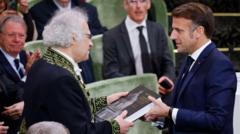NEW YORK (AP) — Merriam-Webster has made a significant move by announcing a complete overhaul of its acclaimed Collegiate Dictionary, set to launch on November 18. The new edition introduces an astounding 5,000 fresh words, including popular terms like 'petrichor', 'teraflop', 'dumbphone', and 'ghost kitchen.'
This 12th edition arrives 22 years after the last substantial print update, highlighting the adaptation of language in a digital age where sales of traditional dictionaries are on a downturn, as reported by Circana BookScan.
Among the intriguing additions, 'petrichor' refers to the distinctive scent produced when rain falls on dry soil, while 'teraflop' gauges computer speed. The term 'ghost kitchen' gained traction during the pandemic, signifying commercial kitchen spaces available for delivery services.
The revamped Collegiate Dictionary includes not just new words but also eliminated sections deemed obsolete, shifting focus towards terms that reflect contemporary culture. When asked about the changes, Greg Barlow, Merriam-Webster’s president, explained, People don’t seek dictionaries for geographical or biographical information anymore; they turn to the internet instead. The update hopes to make the dictionary more appealing and user-friendly, with added visual flair and over 20,000 new usage examples.
Despite the overall decline in print dictionary sales by 9% in the last year, Merriam-Webster remains optimistic. The company sells approximately 1.5 million print dictionaries each year, though digital resources have become paramount for revenue growth, with significant online presence drawing approximately one billion visits annually.
In-store sales at Barnes & Noble, however, buck this trend with a rise in dictionary sales. Marketing manager Kat Sarfas notes a nostalgia-driven desire for physical dictionaries, denoting their value as educational and cultural artifacts.
Ultimately, while digital versions dominate the market, print dictionaries still hold relevance for preserving languages and serving as household references. They symbolize legitimacy and cultural recognition, especially for indigenous languages and lesser-documented dialects.







